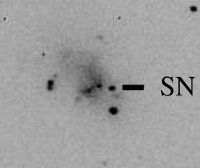“Superluminal Jets in Quasars” — Saturday in Second Life, 10AM PDT
Posted on June 26th, 2009 — permalink
Tomorrow (Saturday) in Second Life I’ll be giving a public talk about the relativistic jets we see emerging from the cores of active galactic nuclei, and in particular I’ll explain how it can be that some of them are apparently moving faster than the speed of light…!
The talk will be at the MICA Large Ampitheater in Second Life at 10AM PDT (Noon CDT, 1PM EDT). Remember, a Second Life account is free! You can join via the SciLands registration portal– if you do, that will take you to the SciLands orientation experience. (StellaNova, the in-world home of MICA, is part of the SciLands.)
Comments Off
Posted in Physics & Astronomy, Science, Second Life, Second Life Events |
“The Speed of Spacetime”, not the “Speed of Light”
Posted on June 25th, 2009 — permalink
That thing that we call the “Speed of Light” — which is, numerically, 3×108 meters per second, or, more elegantly, one light-year per year — is in fact not a property of light itself. Rather, it is a property of spacetime.
Relativity tells us that there is a fundamental speed scale to the Universe. That speed is the “speed of light”. Why it has this value, we don’t know; as far as relativity is concerned, it’s an initial condition, something that just is a property of our particular Universe. This speed scale can also be seen as the natural conversion between space units and time units — the natural scale of our Universe is such that there are 3×108 meters in one second. This speed scale is necessary to talk about “spacetime” instead of space and time as separate things. And, according to the theory of Relativity, they are not separate things. Depending on how one person is moving relative to another person, what one person considers to be pure time will be a mixture of space and time to the other person. How mixed it is depends on their relative velocity.
Relativity has an ultimate speed limit, a speed that nobody with non-zero mass can attain, but can only approach. Nobody is moving faster than the speed of light relative to anybody else. As they accelerate more and more, as they gain more and more momentum and energy, they get closer and closer to the speed of light, but they never quite get there. Meanwhile, particles with zero mass always move at exactly the speed of light (in the absence of a medium with which they interact). Photons happen to be particles of zero mass, but they aren’t the only ones. Gravitons also move at the speed of light– although we have yet to individually detect Gravitons. We have, however, detected (indirectly) gravitational waves, and those (just like light waves) move at the speed of light. That is, the speed of gravity is the same as the speed of light. And, this is no concincidence. In fact, both of them are moving at something more fundamental, the basic speed scale of spacetime.
For this reason, calling this speed limit “the speed of spacetime” would be more accurate than calling it the speed of light– although I grant you that that might be more confusing, and for general use “speed of light” is probably a better term.
Comments Off
Posted in Physics & Astronomy, Science |
The Silent Majority : It’s OK to be both scientific and religious
Posted on June 22nd, 2009 — permalink
Chris Mooney over at The Intersection has a post where he talks about The Silent Majority— the fact that there are a substantial number of people out there who have no trouble reconciling religion and science. The debate is dominated on one side by religious fundamentalists, who deny reality in their efforts to stay faithful to a literal (and, frankly, nonsensical) reading of the Bible. On the other side, that side which is loudest and most strident in the scientific blogosphere, are the militant atheists, the types who think that any form of religious faith whatosever is evidence of stupidity, ignorance, or childishness, and that any form of religious faith is incompatible with good scientific judgement.
However, the truth is, if you talk to the faculty of a science department at just about any college in the country, you’ll find that a substantial number of them (probably well less than half, but not a trivial amount) are regular churchgoers. I suspect you’d find that most are agnostic. You’d find that those who are atheists by and large don’t have a problem with their religious colleagues. There are people who have religious faith, but aren’t fundamentalists and thus that faith doesn’t have to interfere with their science. By the same token, they’re good and rigorous scientists, but they haven’t mistaken the metholdolgy and world-view of science for an all-encompasing perscription for how a rational person must order all of his thoughts.
There are a lot of people out there either with religious faith, or without faith but willing to admit the intellectual worthiness of those with faith, and who also have no problem with the fact of evolution, the overwhelming evidence for global warming, the face of the billions-of-years-old Unvierse, and all of the rest of the things that modern science has taught us. Chris Mooney is on the atheist side of this; I’m on the theist side of this.
Chris asks why the reasonable sorts who don’t feel the need to “hit the rails” and go to one extreme or the other of the debate, aren’t heard from more. Probably because of the Rush Limbaugh effect: those who have an extreme position that involves disdain for those who disagree are able to express it ever so much more entertainingly than those who see value in accomodation. Indeed, I made some posts about my own views on science and religion back when I was in scienceblogs.com, and when I did so I would receive many vicious attacks from the commenters there– those who are to the militant atheist bloggers as “dittoheads” are to Rush Limbaugh.
Whenever you are convinced that you are absolutely right about something– not pretty sure, not even very confident, but absolutely right– you should question yourself. If the vast majority of people who’ve thought deeply about it agree with you, there’s a very good chance that you really are right. For example, I am absolutely convinced that I am absolutely right in believing that evolution happened. The evidence is overwhelming, as the vast majority of people who have seriously looked at that evidence would agree. However, when it comes to the existence or non-existence of God, and to whether acceptance of science forces you to the latter conclusion, look around and acquire some humility– many people have thought a lot about this, and they aren’t all coming to agree that science must equal atheism. Perhaps it is compelling to you, and that’s fine… but if you think that therefore any thinking reasonable person would come to the same exact beliefs that you have come to, the weight of evidence indicates that you’re kidding yourself, just as assuredly as a fundamentalist theist of any stripe is kidding himself about the absolute and universal truth of his faith.
11 Comments
Posted in Science & Religion, science & society |
The mysterious too-dim supernova discovered by a 14-year-old
Posted on June 13th, 2009 — permalink

Supernova SN 2008ha is a particularly interesting supernova, for two reasons. First, because it was discovered by a 14-year old New York student. I would be very interested to know more about how Caroline Moore discovered this supernova. Was she working with a school project? With a professional astronomer’s “crowd sourced astronomy” project? What data did she use? Did she do it herself in her backyard with an amateur telescope and a CCD? Inquiring minds want to know, and if somebody has more information about this, please post a link!
The other thing that’s interesting about this supernova is just how dim it is. In America, of course, it’s strange to say that. We’re always interested in the biggest and baddest. The most distant! The brightest! The most energetic! The most luminous! But, just like “intermediate mass black holes”, this supernova seems to fall into a gap that makes it difficult to understand exactly what it is. Not that there aren’t things that it could be— but the problem is, if anything, there are too many things it could be!
 The press release I link to above describes it as bridging the gap between novae and supernovae, but that may not really be an accurate description. Both novae and thermonuclear supernovae (but not core-collapse supernovae) come from a similar progenitor system. A white dwarf star— a star 1.4 times the mass of the Sun, but only the size of the Earth— pulls matter off of a companion star, probably a red giant. The matter builds up on the white dwarf, until one of two things happen. In a nova, the outer layers of the star get dense enough to trigger nuclear fusion in just those outer layers. An explosion ensues, and we can see it as a nova. The same binary system can produce a nova more than once. In a supernova, the white dwarf star reaches a critical mass known as the Chandrasaekar mass, and the entire 1.4 solar masses of star blows itself away in a tremendous thermonuclear explosion.
The press release I link to above describes it as bridging the gap between novae and supernovae, but that may not really be an accurate description. Both novae and thermonuclear supernovae (but not core-collapse supernovae) come from a similar progenitor system. A white dwarf star— a star 1.4 times the mass of the Sun, but only the size of the Earth— pulls matter off of a companion star, probably a red giant. The matter builds up on the white dwarf, until one of two things happen. In a nova, the outer layers of the star get dense enough to trigger nuclear fusion in just those outer layers. An explosion ensues, and we can see it as a nova. The same binary system can produce a nova more than once. In a supernova, the white dwarf star reaches a critical mass known as the Chandrasaekar mass, and the entire 1.4 solar masses of star blows itself away in a tremendous thermonuclear explosion.
Thermonuclear supernovae are important not just because of what they represent in the potential life cycle of a star, but also because every time they explode, they release about the same amount of energy— The Chandrasaekar Mass is pretty much the same for every star. This has allowed them to be used as “standard candles” in measuring the expansion rate of the Universe, and it was observations of these objects that led us to the discovery that the expansion of the Universe is accelerating.
SN 2008ha was roughly 100 times dimmer than a typical thermonuclear supernova. This wasn’t because it was behind dust; the velocities measured in the expanding gasses were also much lower than is typically observed in a supernova. However, it’s much too luminous to be a mere nova. So what is it? The possibility suggested by the press release is that it really is something between a nova and a supernova: more than the outer layers of the star exploded, but it wasn’t the massive explosion of the entire star. However, if you look at the submitted paper describing follow-up observations of this event, we’re not really sure just what it was. The paper seems to be leaning towards it probably coming from a white, but it’s uncertain as to whether the explosion mechanism was core-collapse or thermonuclear. If the mechanism was core-collapse, then this is much like a very low-luminosity version of a traditional core-collapse supernova that signifies the end of the line for a massive star. In this case, it would be a star that was just barely massive enough to go supernova, and indeed, the supernova might have happened after the star shed its outer layers and left behind a white dwarf. No doubt that further work— observational on this event, and hopefully on more discoveries like this one, as well as theoretical— will be necessary to have a better idea of what really happened.
These events are probably quite rare, indeed probably rarer than normal thermonuclear supernovae (which happen, very roughly, about once per 500 years per galaxy). However, the fact that we only know of one right now shouldn’t be interpreted to mean that it’s a singular event. Thermonuclear supernovae are rare, but they’re bright, so we can see them in distant galaxies, and we’ve developed techniques to find them in great numbers. These dimmer events will be much harder to find.
It’s always exciting when something new, or at least something that shows a new wrinkle, is found in nature.
2 Comments
Tags: supernova supernovae
Posted in Physics & Astronomy, Science |
Wikimedia Commons Pictures of the Year
Posted on June 3rd, 2009 — permalink

Wikimedia Commons is one of those web resources everybody should be aware of. It’s an archive of sounds, animations, and images that are available for your reuse under some sort of Creative Commons licencing (or are public domain). Among other things, you find the images embedded in Wikipedia here.
A link from Boing Boing led me to the 2008 Wikimedia Commons picture of the year. There are quite a number of pictures selected out on that page. To be sure the highest voted pictures are great, but my two favorites were not the top two images.
One was the one I’ve included here— but, of course, it’s an image I’m already familiar with, and one that could be described by the title of this blog! It’s the famous Whirlpool Galaxy, known to amateur astronomers as M51 and to professional astronomers by any number of catalog names (although usually as M51). The galaxy has very strong, very well-defined spiral arms, making it a classic “grand design” spiral. The fact that the spiral arms are so well-defiend is probably as a result of the interaction with the smaller galaxy that’s off to the right in the image. A self-gravitating, rotating disk naturally rings in a spiral density wave pattern when you disturb it, just like the smooth surface of water “rings” in concentric circular waves to a point disturbance (e.g. throwing a rock into the water), or in parallel ripple waves to a plane disturbance (e.g. a steady wind blowing across the water). (You’re probably more familiar with the term “ringing” when applied to the vibrations that occur in a bell when it is disturbed.) The gravitational interaction with the companion galaxy is almost certainly the disturbance causing such a well-defined spiral pattern in the primary galaxy. This particular image of M51 was taken with the Hubble Space Telescope.
I think my favorite image of the set, though, is Reflection in a soap bubble. It’s a beautiful photograph, and it has a sort of Escheresque quality to it. (Exploring the geometry of these sorts of reflections was the sort of thing Escher loved to do.) This is a photograph by Mila Zinkova, and is available under the GNU Free Documentation License. (I don’t believe that I need to make this post available under the GNU FDL simply by including the image, but I could be wrong.)

3 Comments
Posted in Free Culture, Physics & Astronomy, Science |
Renaming the blog
Posted on June 2nd, 2009 — permalink
I have renamed my blog back to “Galactic Interactions”, the name of the blog that I started when I was still an assistant professor of physics & astronomy. After I started working at Linden Lab, I noticed that I wasn’t blogging about astronomy all that much any more, and what’s more I have to admit that I was feeling kind of sad that I wasn’t spending the time thinking about physics & astronomy that would lead me to spontaneously blog about it. As such, closed down my blog on scienceblogs.com and started a new blog entitled “Second Sight”.
Life changes. I no longer work for Linden Lab. Also, over the course of the last year, I’ve become involved with MICA, which has made me more active in the astronomy community — not as active as if it were my job, but it does give me a connection that allows me to keep it up on my own time. Especially given that MICA was founded by people who work in N-body calculations (i.e. the computational/theoretical arm that goes into dealing with, among other things, galaxies interacting), it makes sense for me to rename my blog back to “Galactic Interactions”. So here it is!
I may be changing the look of the blog a bit in coming weeks too. Being the nerd that I am, I don’t find themes or anything like that. I hacked the PHP and HTML for a standard Wordpress theme to get the current look, and I may hack it a bit more to make it more appropriate again to its new/old name.
Comments Off
Posted in About the Blog, Personal Updates |
—


 The press release I link to above describes it as bridging the gap between novae and supernovae, but that may not really be an accurate description. Both novae and thermonuclear supernovae (but not core-collapse supernovae) come from a similar progenitor system. A white dwarf star— a star 1.4 times the mass of the Sun, but only the size of the Earth— pulls matter off of a companion star, probably a red giant. The matter builds up on the white dwarf, until one of two things happen. In a nova, the outer layers of the star get dense enough to trigger nuclear fusion in just those outer layers. An explosion ensues, and we can see it as a nova. The same binary system can produce a nova more than once. In a supernova, the white dwarf star reaches a critical mass known as the Chandrasaekar mass, and the entire 1.4 solar masses of star blows itself away in a tremendous thermonuclear explosion.
The press release I link to above describes it as bridging the gap between novae and supernovae, but that may not really be an accurate description. Both novae and thermonuclear supernovae (but not core-collapse supernovae) come from a similar progenitor system. A white dwarf star— a star 1.4 times the mass of the Sun, but only the size of the Earth— pulls matter off of a companion star, probably a red giant. The matter builds up on the white dwarf, until one of two things happen. In a nova, the outer layers of the star get dense enough to trigger nuclear fusion in just those outer layers. An explosion ensues, and we can see it as a nova. The same binary system can produce a nova more than once. In a supernova, the white dwarf star reaches a critical mass known as the Chandrasaekar mass, and the entire 1.4 solar masses of star blows itself away in a tremendous thermonuclear explosion.
